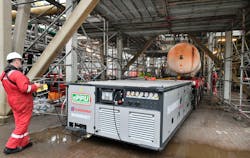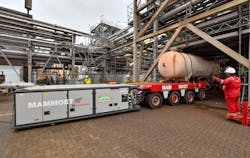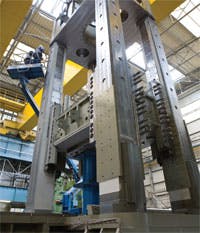World-First: Heavy Electric Transport on a Roll
A major milestone for sustainable heavy lifting and transport, Mammoet has achieved replacing a production vessel using purely electric power at a chemical plant in the Netherlands.
The facility produces feedstock for a range of everyday applications including medical equipment, car components, and cellphones. When a key production vessel needed to be replaced, the customer wanted the lowest possible environmental impact. Thankfully, Mammoet has already explored possible ways new tech can reduce the carbon footprint of projects.
One solution came through a partnership with Scheuerle to transition its Self-Propelled Modular Transporters (SPMT) fleet from diesel to renewable energy. Mammoet had to do extensive research and testing to find a sufficient solution as sPMTs require a lot of force to move heavy items.
In response, Mammoet developed an electric Power Pack Unit (ePPU) used with four axle lines of SPMTs operating in a very tight area of the existing plant, which meant that there were only a few meters in which they could maneuver the existing vessel out and drive the new one into position.
Ludo Mous, Operations Director at Mammoet Europe, explains:
“The ePPU is a really important step in how we support our customers with decarbonizing projects. But in this case, the benefits were not limited only to a lower carbon footprint. With work taking place in a highly confined area, we would have been highly conscious of the emissions generated by a typical diesel PPU, and would need to carefully manage operatives’ exposure to it. By using an electric model, we removed this issue completely, whilst also creating a much quieter working environment.”
The space was so limited that the lines couldn't be positioned beneath the outgoing vessel—it needed to be secured above the front two-axle lines of the SPMT, with the ePPU acting as a counterweight to balance the vessel. A crane was used to remove the old vessel and lower the replacement onto the SPMT in the same position. This was then moved back into place ready to be installed and commissioned, according to Mammoet.
The successful application of the ePPU here signals just the start of an exciting development for Mammoet and the wider industry. Although there is still work to be done to ensure electric power is sufficient for use in larger-scale SPMT projects, the technology is now proven and ready to be rolled out across a broader range of work around the world.
“We were extremely pleased that the ePPU performed as we expected, delivering a low-carbon solution for our customer. We expect demand for it to be high, in particular for projects that are looking for more sustainable options or where exhaust emissions must be kept to a minimum for safety reasons, such as civil projects taking place within tunnels or work inside nuclear facilities,” Mous concludes.
About the Author
Laura Davis
Editor-in-Chief, New Equipment Digest
Laura Davis is the editor in chief of New Equipment Digest (NED), a brand part of the Manufacturing Group at EndeavorB2B. NED covers all products, equipment, solutions, and technology related to the broad scope of manufacturing, from mops and buckets to robots and automation. Laura has been a manufacturing product writer for eight years, knowledgeable about the ins and outs of the industry, along with what readers are looking for when wanting to learn about the latest products on the market.



